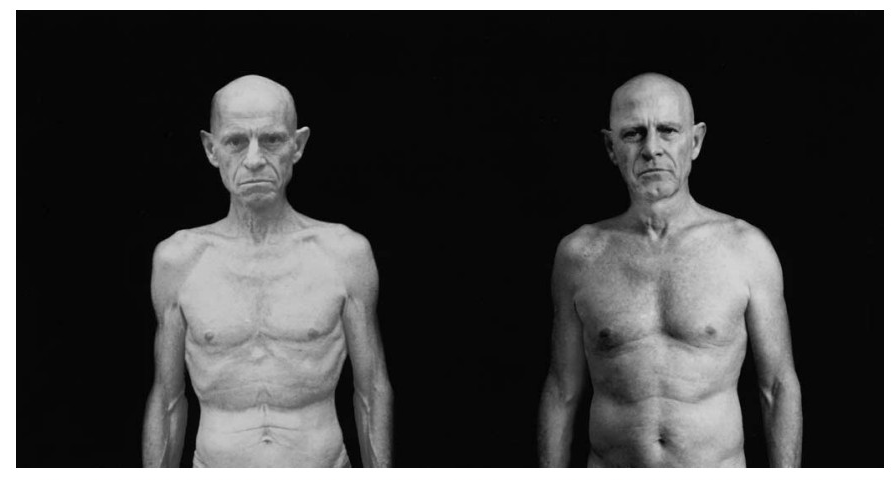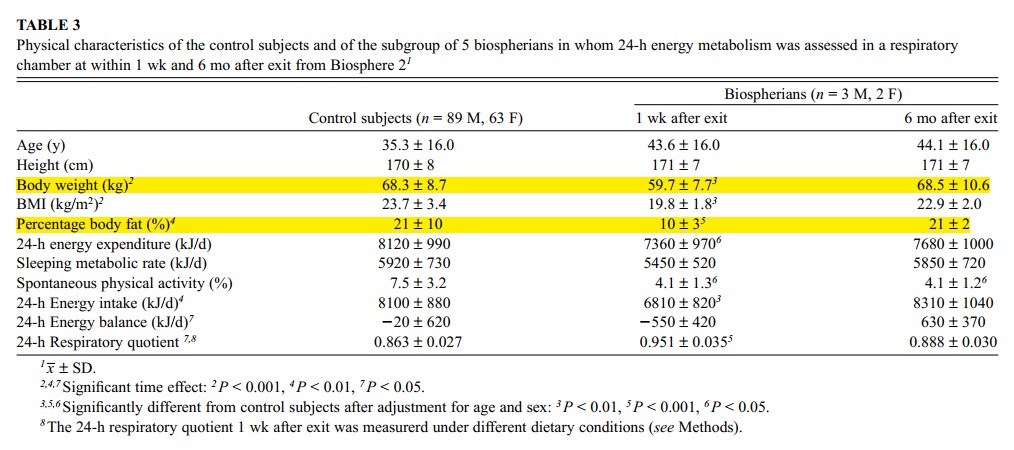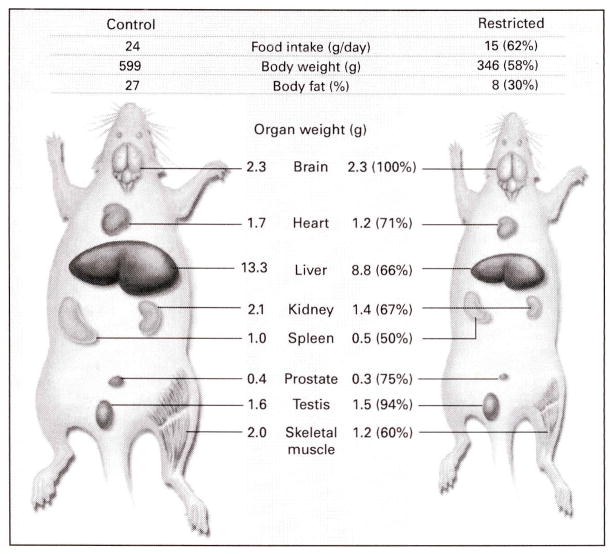Last update and review: May 5, 2020.
Valter Longo was catastrophically wrong during a lecture in 2016.
Walter Longo during a lecture at the Molecular Frontiers Symposium in 2016:
Walford (Roy L. Walford) here (during a calorie restriction experiment), most of his organs, for example, his liver, was probably about (just) half of the size that it was before.
…the muscles, the liver, the heart, everything is much smaller. We know this from mice studies, but obviously you can also tell by just looking at the picture.
Then, he (Walford) exited Biosphere-2 (the 2-year confinement experiment) his (food intake) and his organ size returned to the normal size.

Valter Longo has been using the photo of his mentor, Roy L. Walford, in many of his presentations and lectures for years. Walford is the man in the photo shown by Longo also during a 2016 lecture, as we can see it in the screenshots above.
Walford in the “Biosphere 2” experiment.
Walford participated in the “Biosphere 2” experiment and later published several scientific papers about it. The black and white photo of Walford, where his skeletal and normal looks are shown side by side, is from one of Walford’s published papers on the Biosphere 2. Longo has been using the photo a lot, but Longo does not know what is written in that paper. Indeed, in both papers on the Biosphere 2 experiment published by Walford and his colleagues that we reviewed so far, it is clearly stated that the participants DID NOT regain any lean mass during the 6 months that followed the end of the experiment.
Weyer et al., 2000 (1):
The weight gain was almost entirely accounted for by an increase in fat mass of 8.4 ± 2.2 kg (P < 0.01); however, there was no significant change in fat-free mass (0.4 ± 2.0 kg).


“Biosphere 2″ˆ.
Walford, 1992:
Biosphere 2 is a 3.15-acre space containing an ecosystem that is energetically open (sunlight, electric power, and heat) but materially closed, with air, water, and organic material being recycled. Since September 1991, eight subjects (four women and four men) have been sealed inside, living on food crops grown within. Their diet, low in calories (average, 1780 kcal/day; 1 kcal = 4.184 kJ), low in fat (10% ofcalories), and nutrient-dense, conforms to that which in numerous animal experiments has promoted health, retarded aging, and extended maximum life span.












Weyer et al., 2000:
Unexpectedly, the food supply was markedly restricted during most of the confinement and all subjects experienced a marked, sustained weight loss (9.1 ± 6.6 kg; P < 0.001) from the low-energy (7000–11 000 kJ/d), low-fat (9% of energy), but nutrient dense, diet they consumed.
Organ size in animal models during starvation.
It is well established that organ size in rodents decreases during starvation or caloric restriction. The reduction of organ size was observed by Valter Longo himself, notably in his experiments with the “fast mimicking diet (FMD)” in mice.
Brandhorst et al., (Valter Longo group), 2015 (2):
Reduced organ size and regeneration—FMD (20.5 month), FMD-RF (7 days after resuming the ad lib diet post FMD; 20.5 month) and ad lib fed (16 and 20.5 month) mice were euthanized and organ weights measured. At the end of the FMD, we observed a reduction in organ weight in kidneys, heart, and liver (Fig. 1 L – N), but not in the lungs,
spleen and brain (Fig. S1L – M), and a reduction in body weight (Fig. S1 H – J). The weights of these organs returned to pre-FMD levels after re-feeding.

A diagram explaining rodent organ reduction.
And here is a more informative diagram explaining rodent organ reduction. It is from another study (3).

PhD scientists do not bother to read attentively the papers they cite.
Valter Longo and his “team of over 40 PhDs” often cite the seminal papers on caloric restriction in humans by Walford but did not bother to read them attentively. Instead, 16 years after the paper by Walford and Weyer (1) was published in the year 2000, Valter Longo continues to fantasize about 50% organ reduction and consecutive organ regeneration in fasting or calorically restricted humans.

Below, there is an extract from the transcript of the Ted Talk that Valter Longo gave in 2016. Longo repeats the same fantasies about shrinking and regeneration of organs in human. Valter Longo:
17:06
But the point I’m trying to make is about organs.
17:09
If you look at Roy Walford in the middle, while he was in the Biosphere 2,
17:13
his organs had shrunk to very small levels.
17:16
Like for example, his liver was probably about half of the normal size.
17:19
So half of the size that it was before he entered Biosphere 2 on the left, right?
17:24
And then he exits Biosphere 2 –
17:27
and by the way, I was there when they came out,
17:29
and it was a very stressed out group of people –
17:32
(Laughter)
17:34
but you see now, that’s Walford six months after he exited Biosphere.
17:38
He went back to the same weight,
17:40
and the organs, whether it was the muscle, the heart, the lungs,
17:44
all the different systems are now regenerated, back to the normal size.





There is another important point in the paper by Weyer and Walford (1):
That the weight regain was almost exclusively accounted for by an increase in body fat stores appears to be a characteristic phenomenon that was observed previously in famine victims and emaciated prisoners of World War II (43, 44); in patients with anorexia nervosa (45), cancer (46), sepsis (47), and AIDS (48); and in subjects during the refeeding period of the Minnesota experiment (6, 12). The exact causes for this phenomenon, termed “poststarvation obesity” by Keys et al (6), remain elusive.
More on organ size and regeneration.
Do human organs regenerate after a period of starvation, and if so, to what extent? It is an important question and one of our current research topics. It is well established that human organs diminish in size during prolonged starvation or caloric restriction. Below, there is an informative image that illustrates this fact. The image was published in a 1945 study by Ancel Keys and colleagues. The image shows a dramatic decrease in the size of a human heart during a 6-month period of semi-starvation. The heart lost around 41% of its original size.

Source: Keys, 1945.
The image above was a part of the study that described the Minnesota starvation experiment. We have an article on this website with more information about the experiment. Here, we insert several images to illustrate the physical changes in the study participants.



Conclusions.
Medical practitioners need to be Physiologically Literate on the subject if they want to use fasting and caloric restriction as tools. As we can see from this example of Valter Longo’s presentation, it is far from being the case. Indeed, by the time of writing of this article, almost a million people watched Longo’s 2016 TED Talk. Longo toures podcasts and regularly speaks at conferences in front of medical practitioners and scientists. Longo’s obvious errors have never been corrected by anyone. This means that scientists, medical practitioners, and the masses remain largely ignorant about the physiology of fasting and caloric restriction.
Avoiding errors when practicing “caloric restriction”, “fasting mimicking diet”, fasting, very low carbohydrate diets, zero carbohydrate diets.
If you need help with different restrictive dietary regiments, do not hesitate to get in contact with us.
Selected References:
1. Weyer et al., Am J Clin Nutr 2000;72:946–53.
2. Brandhorst et al., Cell Metab. 2015 July 7; 22(1): 86–99.
3. Weindruch, Sohal, N Engl J Med. 1997 Oct 2; 337(14): 986–994.

This is interesting. I understand Biosphere might also have been plagued by components in atmosphere….specifically increased Nitrogen. I read once that Wolford blamed his neurodegeneration to altered species in what they breathed. However, these days impossible to conduct a starvation experiement like Keys with better monitoring and control of refeeding macros/nutrients. Would higher protein intake result in less adiposity and better body composition? Is there a benefit of autophagy induction, or does long term restriction overwhelm cycling of autophagy and refeeding that happens without starvation during short term fasting?